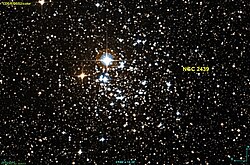| Observation data Epoch J2000 Equinox J2000 | |
|---|---|
| Constellation | Puppis |
| Right ascension | 07h 40m 52.597s [1] |
| Declination | −31° 39′ 40.20″ [1] |
| Apparent magnitude (V) | 6.50 - 6.71 [2] |
| Characteristics | |
| Spectral type | G2 0-Ia [3] |
| U−B color index | +0.85 [4] |
| B−V color index | +1.18 [4] |
| Variable type | SRd [2] |
| Astrometry | |
| Radial velocity (Rv) | +68.22 [1] km/s |
| Proper motion (μ) | RA: −2.251 [1] mas/yr Dec.: +3.222 [1] mas/yr |
| Parallax (π) | 0.2440±0.0180 mas [1] |
| Distance | 13,400 ± 1,000 ly (4,100 ± 300 pc) |
| Absolute magnitude (MV) | −7.8 [5] |
| Details | |
| Mass | 14.3 [6] M☉ |
| Radius | 477+28 −22 [7] R☉ |
| Luminosity | 96,600±26,100 [7] L☉ |
| Surface gravity (log g) | 0.30 [8] cgs |
| Temperature | 5,495; (4,100±68 –6,500) [8] K |
| Metallicity [Fe/H] | −0.25 [8] dex |
| Other designations | |
| CD−31°4910, GSC 07106-03582, HIP 37415, HR 2974, HD 62058 | |
| Database references | |
| SIMBAD | data |

R Puppis is a variable star in the constellation Puppis. It is a rare yellow hypergiant and a candidate member of the open cluster NGC 2439. It is also an MK spectral standard for the class G2 0-Ia. [9]

